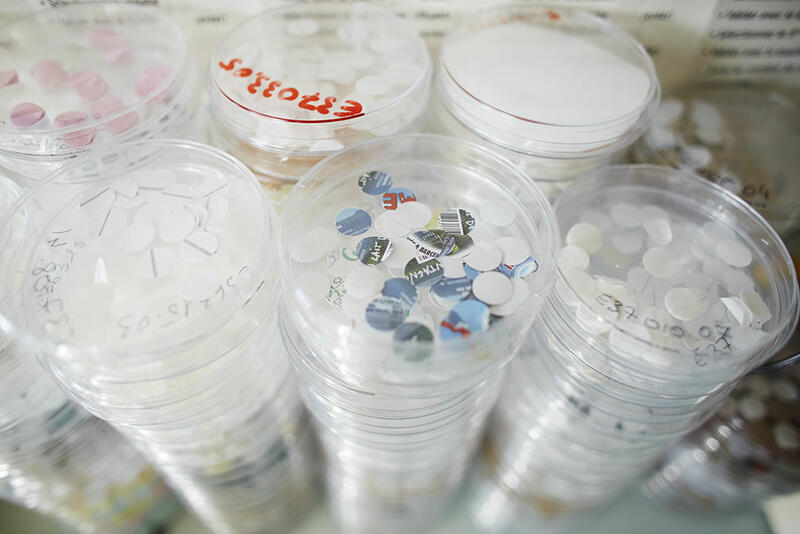
Analyses compliant with the French Information Note from DGCCRF – Fiche MCDA N°4
Food contact compliance of plant fibre-based organic materials
- Requirements concerning uncoated and coated papers and boards, multimaterial (complex) products, primary, secondary and tertiary packaging, etc.
- Uses for food packaging, baking, kitchen roll and napkins, tableware (plates, cups, etc.)
- January 2019 version
General informations
French Information Note – Fiche MCDA N°4, which was issued by the French General Directorate for Competition Policy, Consumer Affairs and Fraud Control (DGCCRF) in January 2019, stipulates major updates regarding the tests that are required to guarantee the compliance of paper/board materials for food contact. It specifies the criteria and conditions for checking food contact compliance, and more particularly the conditions for checking the inertia principle laid down in article 3 of European Framework Regulation (EC) no. 1935/2004.
The three laboratories that form the Food Contact unit at the CTP are equipped to perform chemical, microbiological and sensory analyses for verifying compliance with these requirements. The laborato-ries hold COFRAC accreditation no. 1-0552 (scope of accreditation available on www.cofrac.fr), guaranteeing that the expertise offered by the CTP is comprehensive and independent.
The CTP also organises training courses and can provide technical assistance and advice concer-ning Good Manufacturing Practices (GMP).
Technical data and achievements
The inertia of a paper/board material is broken down into several key stages and varies depending on its foreseeable conditions of use and whether a functional barrier is present.
Foreseeable conditions of use
These are the first data that must be provided as they will have an impact on the entire analysis process.
- Type of contact: dry, aqueous, acidic, alcoholic and/or fatty
- Contact time: a possible estimated time of less than 5 minutes, several hours, several days or more than 30 days
- Contact temperature: ambient temperature or lower, up to 90°C, or cooking temperature in a microwave or an oven.
Overall migration
The overall migration limits required depend on the type of paper/board packaging studied:
- paper/board packaging with a polymer coating: maximum 10 mg/dm², XP CEN/TS 14234 standard for fatty contact and NF EN 1186 standard for aqueous contact (not applicable in the case of dry and non-fatty contact)
- uncoated paper/board : maximum 60 mg/kg, ÖNORM A-1123 standard for a gas-phase migration into dry foodstuffs.
Specific migrations
The specific migration of a substance is assessed once the migration or extraction into simulant(s) has been completed: cold (EN 645) or hot (EN 647) water-based extraction, migration into 3% acetic acid (based on EN 645 or EN 647), Tenax©/MPPO (NF EN 14338), or using solvents such as 50% or 95% ethanol and iso-octane (NF EN 15519 or 13130).
They concern:
- Phthalates and other plasticisers
- Cross-linking agents and photoinitiators
- Bisphenol A (BPA)
- Primary Aromatic Amines (PAA)
- Polycyclic aromatic hydrocarbons (PAH)
- Mineral oil hydrocarbons (MOSH/MOAH)
- Extractible metals: lead (Pb) and mercury (Hg)
- Pentachlorophenol (PCP)
- Perfluorooctanoic acid (PFOA)
- Optical brightening agents
- Pigments and dyes
See “Test sheet: study of overall and specific migrations” for more technical details.
Organoleptic properties
The organoleptic inertia of a material must be checked to comply with point 13 of the sheet. The qualified panels at the CTP are trained to detect the odour emitted by a paper/board material (EN 1230-1) and any off-flavours transmitted to foodstuffs (EN 1230-2, ISO 13302 or DIN 10955 depending on the case).
Antimicrobial substances
No inhibition zones must appear around the paper and board during tests carried out in line with the EN 1104 standard.
 |
 |
|
| Primary packaging in contact with a foodstuff | Paper packaging samples analysed |